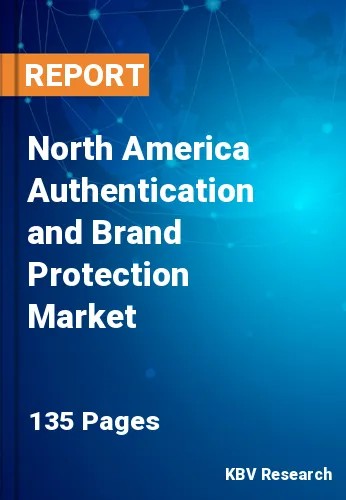The North America Authentication and Brand Protection Market would witness market growth of 7.6% CAGR during the forecast period (2023-2030).
The emphasis on maintaining brand and product integrity, the adoption of strict anti-counterfeiting standards, and restrictions implemented by government bodies, in addition to the manufacturing sector's ongoing expansion, all support the market's expansion. Numerous brand owners are pressured to address these challenges to safeguard their commercial interests due to the growing susceptibility to counterfeit attacks, diversions, and tampering problems. They are concentrating on creating a thorough trademark protection program that involves legal marketing entities, law enforcement, customs, and investigation while also developing a strong product authentication strategy.
The availability of counterfeit goods is rapidly growing, embracing products from various sectors, including food and beverage, chemicals, consumer electronics, automotive components, medical equipment and medicines, and agriculture. Many industries, from tobacco to consumer electronics, are moving toward authentication and trademark protection systems due to the rising forgery difficulties. Since they could potentially endanger customers, counterfeit products are difficult to identify from their genuine equivalents and damage a company's reputation.
According to the United States Small Business Administration, cross-border e-commerce will generate more than $700 billion in sales by 2023. This is primarily due to improvements in logistics, customs procedures, and marketing and opportunity strategies that enable customers to purchase goods directly from American firms. Additionally, there is a significant presence of US-made goods in various nations, which has led to a rise in the popularity of protecting the brand through product authentication.
American equipment producers invest a large sum of money to guarantee the reliability of their goods. Moreover, with a 2.1% market share, pharmaceutical sales in Canada rank as the ninth-largest market in the world. Compound yearly growth has been positive at 5.1% since 2015. Brand-name goods comprise 27.1% of prescriptions written in Canada and 81.3% of total sales. Thus, more regional manufacturers are deploying systems to protect their product identification. Therefore, all these elements will boost the demand for and market growth.
The US market dominated the North America Authentication and Brand Protection Market by Country in 2022, and would continue to be a dominant market till 2030; thereby, achieving a market value of $1,260 million by 2030. The Canada market is experiencing a CAGR of 10.1% during (2023 - 2030). Additionally, The Mexico market would exhibit a CAGR of 9.1% during (2023 - 2030).
Based on Offering, the market is segmented into Barcodes & QR Codes, Security Labels & Inks, RFID/NFC, Holograms and Authentication Chips. Based on Application, the market is segmented into Pharmaceuticals, Food & Beverages, Electronics, Automobile, Apparel, Luxury Goods, Cosmetics and Others. Based on Technology, the market is segmented into Overt, Covert, Digital and Forensic. Based on Authentication Mode, the market is segmented into Blockchain and Smartphone. Based on countries, the market is segmented into U.S., Mexico, Canada, and Rest of North America.
Free Valuable Insights: The Worldwide Authentication and Brand Protection Market is Projected to reach USD 5.1 Billion by 2030, at a CAGR of 8.2%
The market research report covers the analysis of key stake holders of the market. Key companies profiled in the report include Authentix Inc., Avery Dennison Corporatio, Brady Corporation, De La Reu plc, WISeKey International Holding Ltd, Infineon Technologies AG, Merck KGaA, Assa Abloy AB, Centro Grafico DG and Optel Group.
By Offering
By Application
By Technology
By Authentication Mode
By Country
Our team of dedicated experts can provide you with attractive expansion opportunities for your business.

